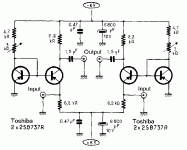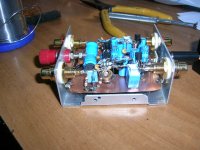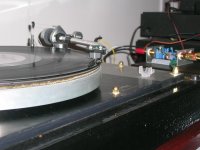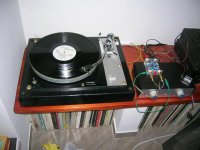Hi all
Regarding the Marshall Leach head amp that pdul kindly proposed, I found these links:
Article by prof. Marshall Leach (I think he says all he has to say):
Moving Coil Cartridge Head Amps
Construction of the common emitter version:
Headphono
Opinions for transistor replacement:
substitutes for BC413C/414C/415C/416C
Hi sam
Nice construction of your head amp.
May I ask you which are the other mc-pre you have built?
Best Regards
George
Regarding the Marshall Leach head amp that pdul kindly proposed, I found these links:
Article by prof. Marshall Leach (I think he says all he has to say):
Moving Coil Cartridge Head Amps
Construction of the common emitter version:
Headphono
Opinions for transistor replacement:
substitutes for BC413C/414C/415C/416C
Hi sam
Nice construction of your head amp.
May I ask you which are the other mc-pre you have built?
Best Regards
George
Thank you very much for this pdf URL - some interesting advices, especially if I must use bipolare versions in a NFB loop for unity gain by DC signals.Hi tiefbassuebertr
About the bipolar caps, a lot of URLs, but basically they all refer to Cyril Bateman articles in Wireless World magazine.
A sum-up is here: http://www.diycore.com/patrick/files/electronics/capacitor/Cap_fallacies.pdf
Best regards George
Because you have a voltage bias at the base (input pin) of LM394, the last mentioned of post #47 is correct solution. For you the royal way is one normal unipolare electrolytic capacitor with the "+" pin to the base connector of LM394 (approx. 68 uF or 100uF). Please use a 63 volt or 100 volt version, because this voltage sizes are in most cases optimal for best sonic transmission (my subjectice impression). Add a bypass (MKP capacitor of 470nF or more) parallel of this electrolytic capacitor.
tiefbassuebertr
You are welcome.
I will follow your input capacitor recommendation.
Best Regards
George
You are welcome.
I will follow your input capacitor recommendation.
Best Regards
George
hi Tony. i know the Hiraga Pre-Pre very well and i also bypass the current source sometimes for lower noise (with a very high value like 2200uF). i use that 100 Ohm resistor and elcaps in the bias arrangement of the folded cascodes in the second stage of my MPP but have not seen them directly in low noise input stages. i thought they would be noisy there. i could imagine that your design does not need very big elcaps because the impedance is higher. anyway, thanks for that little nice trick. do you think it improves the sound and how ? i have added a circuit that you could look over just to avoid misunderstanding. it is an NPN version. are the 200uF and the 100 ohm resistor in the right position ?
Attachments
Hi Joachim,
yes the E-cap is in the right position.I tested different brands of e-caps and values in this location.Best resuluts by a wide margin with Black Gate NX 100uF 6.3V in antiparallel configuration(2 per channel)This caps are nonpolar. The improvement is unbeliveble. They have a presence and air never heared before.Without all magic is gone.
The only supplier have this caps in stock is auduotuning in Berlin
regards Tony
yes the E-cap is in the right position.I tested different brands of e-caps and values in this location.Best resuluts by a wide margin with Black Gate NX 100uF 6.3V in antiparallel configuration(2 per channel)This caps are nonpolar. The improvement is unbeliveble. They have a presence and air never heared before.Without all magic is gone.
The only supplier have this caps in stock is auduotuning in Berlin
regards Tony
hi tony.
i use 22uF bipolar black gate bypassed with 0.1uF röderstein mkp in the signal pass of my poweramp. i agree, they sound amasing.
i use 22uF bipolar black gate bypassed with 0.1uF röderstein mkp in the signal pass of my poweramp. i agree, they sound amasing.
Hi Joachim,
yes the E-cap is in the right position.I tested different brands of e-caps and values in this location.Best resuluts by a wide margin with Black Gate NX 100uF 6.3V in antiparallel configuration(2 per channel)This caps are nonpolar. The improvement is unbeliveble. They have a presence and air never heared before.Without all magic is gone.
The only supplier have this caps in stock is auduotuning in Berlin
regards Tony
I think you mean such capacitors from Rubycon and ELNA
http://www.musicaldesign.com/images/100_16FK.jpg
I have observed by repair service of some audio devices (mainly compact disc players of the higher price class), that this kind of capacitors leak out.
The spilled liquid on the PCB top looks like the already dried solder residues and therefore it is very difficult to make pictures (photos).
Unfortunately, over time the PCB conductors and other components in the environment through oxydation strongly attacked.
From others I have heard the same very unpleasant problems. (Google keyword: bad caps - search by images)
Because the electrolytic liquid may be toxic (and very strong smell of rotten fish) that is really not funny to perform a thorough cleaning of the PCB.
If I have more background information about the exactly reasons for this, I will start a new threat.
Therefore don't broke following rule in generall:
Never the use of electrolytic capacitor versions offered as a "Special Made for Audio" !!!
Neither for repair and modification service and never for new designs !!!
Check out the websites of the follow brands and ask about appropriate versions for military, industry and aerospace:
WIMA - Kondensatoren für die Elektronik
ARCOTRONICS Landsberg am Lech - Kondensatoren
Evox Rifa
Then you will automatically receive the best possible audio quality, because it isn't design only for hifi stuff by consumer.
Last edited:
to gpapag
Yes. I am actually using it with my Dynavector 17 karat 2 with a fantastic result.
This diagram is from LC audio, but the one i am using came from a diy project
in a Danish HI FI magazine back in 92 but it is basically the same🙂
Yes. I am actually using it with my Dynavector 17 karat 2 with a fantastic result.
This diagram is from LC audio, but the one i am using came from a diy project
in a Danish HI FI magazine back in 92 but it is basically the same🙂
🙂By the way!
I think LC audio is still selling pairs of b737/d786 on their website, if anyone feel like trying the setup
I think LC audio is still selling pairs of b737/d786 on their website, if anyone feel like trying the setup
the rositer amp from audioxpress is eVen better with 10 times less distortion. i used a cicuit like the LC audio back in 1982 without knowlage of the leach even before the hiraga. it is really nothing new and can be much improved today. i got -110dB distortion ( only second) in my MPP without NFB. that is even an order of magnitude better then the rositer. i get really a bit tired advertising advantages in the last 25 years. audiophiles seam to be extremely conservative sometimes.
audiophiles seem to be extremely conservative sometimes
I guess I am conservative too. So my wife says: “20 years that we are married and you practice the same positions over and over again”.
I try to convince her that I am trying hard to educate myself, by reading magazines, watching XX films, asking people, but in the end, the act is only 2 times a month.
I have to do my duty properly, so I turn to proven practices, that’ why the blame.
Had I had a mistress…..🙂🙂🙂
Dear Joachim
As I read, you are a very competitive designer with solid knowledge, so you have the right to express your frustration that people (like me) try to implement aged circuits.
Well, for me the attraction of these circuits is their simplicity-because this is my capability, to build simple circuits- accompanied by a good record of positive testimonials about how they sound.
But at least in diyaudio.com there are a lot of people who can appreciate properly designed circuits, who are after very low distortion designs and who can build relatively or very complex circuits.
Diversity is I think one of the things that makes the world turn around.
Your very friendly attitude and the generous publishing of your designs is well appreciated by all, even by the conservatives too.
Best Regards
George
Last edited:
Hi George,
You can't go wrong with this
http://www.diyaudio.com/forums/chip-amps/81630-phono-stage-stepup-opamps.html 🙂
You can't go wrong with this
http://www.diyaudio.com/forums/chip-amps/81630-phono-stage-stepup-opamps.html 🙂
hello george !
i do not intend to critisise you in any way. i am simply surprised that people think the Hiraga is a great sounding desing. it has 100 x more distortion then necessary and your design is much lower in distortion at the expense of an input capacitor that will unfortunately destroy some delicate sounds in the upper treble. why women critsise our hobby is a mystery to me. it keeps you home with the family.
i do not intend to critisise you in any way. i am simply surprised that people think the Hiraga is a great sounding desing. it has 100 x more distortion then necessary and your design is much lower in distortion at the expense of an input capacitor that will unfortunately destroy some delicate sounds in the upper treble. why women critsise our hobby is a mystery to me. it keeps you home with the family.
here is a dc coupled version of your pre although it has elcaps in the feedback (could be used as subsonic filter). values are not dimensioned yet. it will reduce 2nd harmonic, the major source of distortion in your design although it is not a big problem because you use feedback. with 2N4403, 2N4401, BD139, BD140, selected for maximum and equal current gain and batteries it could be build for 20 Euros a pair. the fet could be BF245 and the gate resistors could be used for DC trimming. BD139,140 could be substituted with higher hfe types. if you can not find 2N4403 and 2N4401 take two BC550C, BC560C in parallel. four of them are surprisingly quite and they sound very good and are dirt cheep. i like simplicity too and can drive a hard bargain if that is the goal but i hate to compromise too much on topology.
Attachments
the open loop gain of that circuit is quite high so you should use miller compensation somewhere to avoid oscillation.
Rossiter MC
Hello Joachim,
you built the Rossiter MC? Is it suitable for the DL103?
This is a very interesting design, but just for the ortofon cartridges I thought.
And the other thing was , there are still caps in the signal path.
Regards
Sam
Hello Joachim,
you built the Rossiter MC? Is it suitable for the DL103?
This is a very interesting design, but just for the ortofon cartridges I thought.
And the other thing was , there are still caps in the signal path.
Regards
Sam
yes, the rositer has caps but it measures and sounds very well if you use good parts. the rositer can be bettered though and i posted a plethora of circuits here that are candidates. i do not know how it sounds with the denon. it has an input impedance of ca.25 Ohm and the denon has quite high impedance coils for an mc. i still do think it works. look at the phonoclone. it has zerro ohm impedance but i do not read reports with dificulties with any mc.
Hi all
Being in a quite difficult position to post anything readable (ich bin blau), I repot that the AN-222 Fig-4 circuit is being in it’s final (if ever) state of implementation.
It is now housed in a screened (to be ) enclosure.
It performs decently, and I would like to confess that using as an excuse the polishing out -working in- my DLie and burning in this much suffering Pre Amp circuit , I have spent several hours going through my soul and rock music album collection.
The whole thing is going quite right, though I have observed for one more time that the available power output is never enough!
Due to this burning in and due to the fact that this particular analogue front end is to be used for reproducing opera and chamber music in the future, I am more than sure that it is going to face an identity problem (exactly just like it’s owner).
More technical details will follow tomorrow, when I will get rid of the 1+litter of liqueur that I have acquired this night.
PS 1. How is it that every time that I am getting “high” is when the music comes from an analogue source?
Ps 2. I know that tomorrow I will feel ashamed and embarrassed seeing this post in here, but that may be OK. Friends are here for.
Best Regards
George
Being in a quite difficult position to post anything readable (ich bin blau), I repot that the AN-222 Fig-4 circuit is being in it’s final (if ever) state of implementation.
It is now housed in a screened (to be ) enclosure.
It performs decently, and I would like to confess that using as an excuse the polishing out -working in- my DLie and burning in this much suffering Pre Amp circuit , I have spent several hours going through my soul and rock music album collection.
The whole thing is going quite right, though I have observed for one more time that the available power output is never enough!
Due to this burning in and due to the fact that this particular analogue front end is to be used for reproducing opera and chamber music in the future, I am more than sure that it is going to face an identity problem (exactly just like it’s owner).
More technical details will follow tomorrow, when I will get rid of the 1+litter of liqueur that I have acquired this night.
PS 1. How is it that every time that I am getting “high” is when the music comes from an analogue source?
Ps 2. I know that tomorrow I will feel ashamed and embarrassed seeing this post in here, but that may be OK. Friends are here for.
Best Regards
George
Attachments
- Status
- Not open for further replies.
- Home
- Source & Line
- Analogue Source
- Head Pre for Denon DL 103



